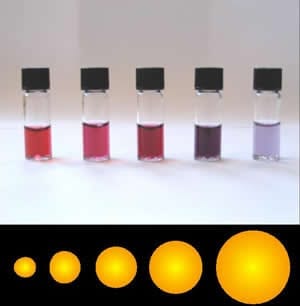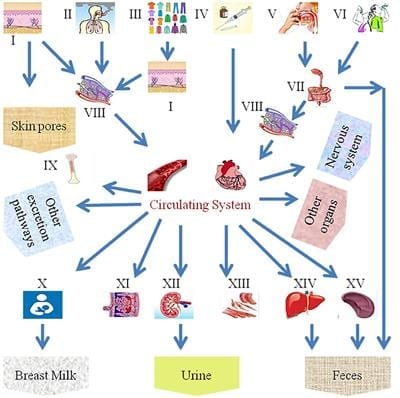Gold nanoparticles with special coatings can deliver drugs or biosensors to a cell’s interior without damaging it
Cells are very good at protecting their precious contents — and as a result, it’s very difficult to penetrate their membrane walls to deliver drugs, nutrients or biosensors without damaging or destroying the cell. One effective way of doing so, discovered in 2008, is to use nanoparticles of pure gold, coated with a thin layer of a special polymer. But nobody knew exactly why this combination worked so well, or how it made it through the cell wall.
Now, researchers at MIT and the Ecole Polytechnique de Lausanne in Switzerland have figured out how the process works, and the limits on the sizes of particles that can be used. Their analysis appears in the journal Nano Letters, in a paper by graduate students Reid Van Lehn, Prabhani Atukorale, Yu-Sang Yang and Randy Carney and professors Alfredo Alexander-Katz, Darrell Irvine and Francesco Stellacci.
Until now, says Van Lehn, the paper’s lead author, “the mechanism was unknown. … In this work, we wanted to simplify the process and understand the forces” that allow gold nanoparticles to penetrate cell walls without permanently damaging the membranes or rupturing the cells. The researchers did so through a combination of lab experiments and computer simulations.
The team demonstrated that the crucial first step in the process is for coated gold nanoparticles to fuse with the lipids — a category of natural fats, waxes and vitamins — that form the cell wall. The scientists also demonstrated an upper limit on the size of such particles that can penetrate the cell wall — a limit that depends on the composition of the particle’s coating.
The coating applied to the gold particles consists of a mix of hydrophobic and hydrophilic components that form a monolayer — a layer just one molecule thick — on the particle’s surface. Any of several different compounds can be used, the researchers explain.
“Cells tend to engulf things on the surface,” says Alexander-Katz, an associate professor of materials science and engineering at MIT, but it’s “very unusual” for materials to cross that membrane into the cell’s interior without causing major damage. Irvine and Stellacci demonstrated in 2008 that monolayer-coated gold nanoparticles could do so; they have since been working to better understand why and how that works.
Since the nanoparticles themselves are completely coated, the fact that they are made of gold doesn’t have any direct effect, except that gold nanoparticles are an easily prepared model system, the researchers say. However, there is some evidence that the gold particles have therapeutic properties, which could be a side benefit.
Gold particles are also very good at capturing X-rays — so if they could be made to penetrate cancer cells, and were then heated by a beam of X-rays, they could destroy those cells from within. “So the fact that it’s gold may be useful,” says Irvine, a professor of materials science and engineering and biological engineering and member of the Koch Institute for Integrative Cancer Research.
Significantly, the mechanism that allows the nanoparticles to pass through the membrane seems also to seal the opening as soon as the particle has passed. “They would go through without allowing even small molecules to leak through behind them,” Van Lehn says.
Irvine says that his lab is also interested in harnessing this cell-penetrating mechanism as a way of delivering drugs to the cell’s interior, by binding them to the surface coating material. One important step in making that a useful process, he says, is finding ways to allow the nanoparticle coatings to be selective about what types of cells they attach to. “If it’s all cells, that’s not very useful,” he says, but if the coatings can be targeted to a particular cell type that is the target of a drug, that could be a significant benefit.
The Latest Bing News on:
Gold nanoparticles
- Solving A 400-Year-Old Alchemical Enigma: The Mystery Behind Purple Gold Explosions?on April 26, 2024 at 4:01 am
After all, it’s only now, after 400 years of advancements in chemistry and physics, that we’ve finally solved the mystery of how they were creating purple explosions all those years ago. Fulminating ...
- New method could detect early ovarian cancer from urine samples,claims researchon April 25, 2024 at 3:45 pm
New research by Joseph Reiner and colleagues at Virginia Commonwealth University shows promise for a urine-based test for ovarian cancer. Reiner will present their research at the 68th ...
- World's thinnest gold leaf, dubbed 'goldene,' is just 1 atom thickon April 25, 2024 at 12:22 pm
Scientists have created the world's thinnest gold leaf, which is just a single atom thick. The new material, dubbed "goldene," could have important applications in carbon dioxide conversion and ...
- Panjab University gets patent for dual-function novel peptideon April 24, 2024 at 8:00 pm
PSA is used for early diagnosis of prostate cancer in the healthcare system and semen detection in sexual assault cases ...
- Bioelectronic chip detects vitamins C and D in saliva in under 20 minuteson April 24, 2024 at 9:39 am
Researchers at the University of São Paulo (USP) in Brazil have developed a bioelectronic chip that simultaneously detects vitamins C and D in body fluids. It is flexible and easy to see and can be ...
- New sustainable diagnostic approach offers precision cancer testing with minimal environmental impacton April 24, 2024 at 3:51 am
In a recent study in Nature Sustainability, researchers describe a diagnostic approach that combines dried sera spots (DSS) with nanoparticle-enhanced laser desorption and ionization mass ...
- Scientists Create New 2D Form of Gold Called Goldeneon April 23, 2024 at 6:00 am
They added gold atoms to the top of the stack, but those atoms didn't stay put. Due to the electrochemical properties of gold and silicon, the gold atoms diffused into the layered structure and ...
- Researchers set new standards for nanoparticles, helping patients with MS, ALS, Parkinson's diseaseon April 19, 2024 at 9:31 am
Is it possible for nanoparticles to go through the digestive system and deliver medicine directly to the brain tissue? Researchers from Michigan State University say yes, and their latest findings are ...
- Metal Nanoparticles Market Size 2024 Global Comprehensive Growth, Research Statistics, Business Strategy, Regional Forecast to 2024 to 2032on April 18, 2024 at 2:41 pm
Request To Download Free Sample of This Strategic Report @- https://reportocean.com/industry-verticals/sample-request?report_id=bw5337 ...
- Meet ‘goldene’: this gilded cousin of graphene is also one atom thickon April 17, 2024 at 5:00 pm
Goldene is a gilded cousin of graphene, the iconic atom-thin material made of carbon that was discovered in 2004. Since then, scientists have identified hundreds more of these 2D materials. But it has ...
The Latest Google Headlines on:
Gold nanoparticles
[google_news title=”” keyword=”Gold nanoparticles” num_posts=”10″ blurb_length=”0″ show_thumb=”left”]
The Latest Bing News on:
Cell-penetrating mechanism
- A Novel Cellular Mechanism Used to Repair DNA Damage is Revealedon April 25, 2024 at 7:05 pm
The human genome is contained within the nucleus of cells. The genome is well protected, but many things can cause DNA damage, including aging, some drugs.. | Cell And Molecular Biology ...
- Trial underway for Billings man accused of shooting woman, two teenson April 23, 2024 at 5:15 pm
In mid-August 2023, Billings law enforcement agents filled the streets of the Golden Meadows Mobile Home Park. They gathered in response to a shooting reported from one of the homes in which three ...
- Low-frequency noise is pervasive. Does that matter?on April 17, 2024 at 5:00 am
Sounds that are lower pitched are less studied than other types. Some say it’s a health hazard. Others have doubts.
- How the body prevents multiple sperm from fertilizing an eggon March 14, 2024 at 1:48 pm
This mechanism effectively prevents additional sperm from penetrating the ZP ... The full study was published in the journal Cell. Like what you read? Subscribe to our newsletter for engaging ...
- Breakthrough in CRISPR delivery promises safer gene editingon March 6, 2024 at 4:00 pm
Further research is crucial for developing safer and more precise delivery mechanisms for CRISPR ... while innovations such as cell-penetrating peptides and lipid nanoparticles (LNPs) offer ...
- Heat Healer’s New At-Home Sauna Harnesses Red Light, Infrared, and PEMF Therapieson March 6, 2024 at 9:33 am
“PEMF works by penetrating deep into your body while stimulating the mitochondria in your cells. Your mitochondria are the powerhouse within your cells and are responsible for producing ATP ...
- Cell Penetrating Peptides to Improve Cytosolic Drug Deliveryon May 13, 2022 at 5:40 pm
their mechanism of action, and their applications for delivering peptides and proteins in vitro and in vivo. After this presentation you will discover how Cyclic CPPs may finally realize the potential ...
- Driving drug development through next-generation oligonucleotide technologyon September 4, 2020 at 9:12 pm
OliX’s product-development pipeline is based on its cell-penetrating asymmetric small ... these types of scars are not based on the disease mechanism, and so have little efficacy or are ...
- Nuclear-penetrating, DNA-binding antibodies as cancer therapieson September 3, 2020 at 9:43 pm
“No one else is developing this sort of cell-penetrating antibody as a cancer ... PAT-DX1 exploits the fact that, although all cells have mechanisms to repair damaged DNA, these DNA damage ...
The Latest Google Headlines on:
Cell-penetrating mechanism
[google_news title=”” keyword=”cell-penetrating mechanism” num_posts=”10″ blurb_length=”0″ show_thumb=”left”]











